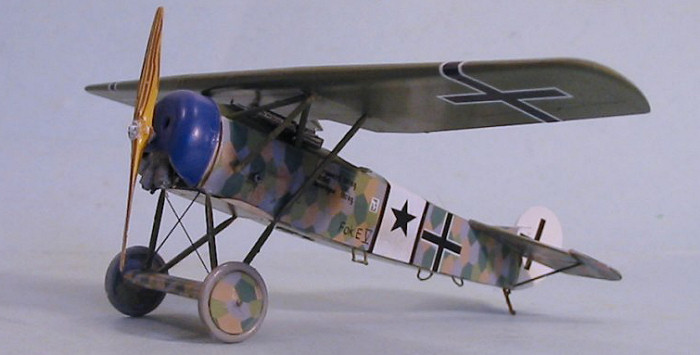
| KIT #: | 8096 |
| PRICE: | $34.98 MSRP |
| DECALS: | Four options |
| REVIEWER: | Tom Cleaver |
| NOTES: |

| HISTORY |
The E.V/D.VIII is what could be called today a “celebutante,” i.e., a thing famous for being famous. Only 136 of these airplanes were built in total, and the combat career of the Fokker “Parasol,” as it was known to the pilots, was cut off within a matter of days of its first combat as the result of in-flight wing failures due to shoddy workmanship and poor quality control of the wing design at the factory - the bane of Fokker’s products throughout the war. It only re-entered production as the D.VIII with a strengthened wing barely five weeks before the end of the war, and there were never more than 85 Parasols in the inventory of the Fliegertruppen at any given time. Though some famous aces like Theo Osterkamp and Gotthard Sachsenberg flew it for a few hours, none of them ever scored a victory while using this airplane during the war, and the total number of Allied airplanes known to be shot down by pilots flying the Parasol doesn’t even reach double digits. Nevertheless, the E.V/D.VIII is a well-known German fighter of the First World War.
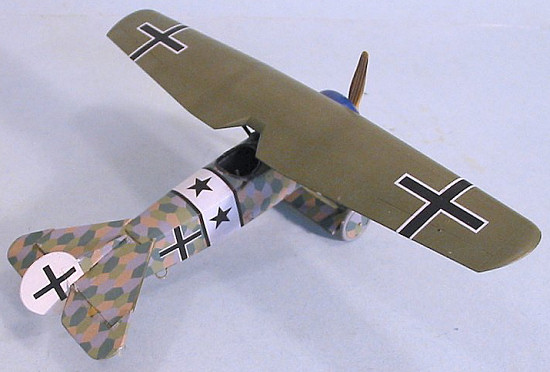 The
original Fokker fighter monoplane was gone from aerial combat by the summer of
1916, but Anthony Fokker never lost his belief in the inherent superiority of
such a design over the biplane. This was strengthened by his alliance with Hugo
Junkers, which allowed him to fly the all-metal monoplanes that company had
developed. In December 1917, Fokker began development of the V 17, a midwing
monoplane in which the wing was of all-wood construction. This airplane was
flown at the First Fighter Competition at Adlershof in late January 1918, where
the report said “The V 17 was the fastest machine at the Competition. With
regard to climb, it is slightly better than the V 11 (which later became the
D.VII). It is tremendously maneuverable, but has the disadvantage that the
forward-placed wing gives the pilot poor visibility while taking-off and
landing.” As a result, Idflieg gave Fokker an order for the
construction of several cantilever-winged monoplane fighters, to be ready for
the Second Fighter Competition scheduled in June 1918.
The
original Fokker fighter monoplane was gone from aerial combat by the summer of
1916, but Anthony Fokker never lost his belief in the inherent superiority of
such a design over the biplane. This was strengthened by his alliance with Hugo
Junkers, which allowed him to fly the all-metal monoplanes that company had
developed. In December 1917, Fokker began development of the V 17, a midwing
monoplane in which the wing was of all-wood construction. This airplane was
flown at the First Fighter Competition at Adlershof in late January 1918, where
the report said “The V 17 was the fastest machine at the Competition. With
regard to climb, it is slightly better than the V 11 (which later became the
D.VII). It is tremendously maneuverable, but has the disadvantage that the
forward-placed wing gives the pilot poor visibility while taking-off and
landing.” As a result, Idflieg gave Fokker an order for the
construction of several cantilever-winged monoplane fighters, to be ready for
the Second Fighter Competition scheduled in June 1918.
The V 28, a parasol monoplane with a rotary engine for power, was the prototype for the E.V/D.VIII, and it competed at the Second Competition, though it was actually ordered into production before the competition with the first examples accepted two weeks before that event.
The decision to produce the V 28 was taken on the basis of reports that - powered by the Goebel Goe II engine, it was capable of climbing to 16,405 ft in 11 minutes, an extraordinary performance. 60 Fokker D.VI biplanes were canceled to provide their engines to the E.V production.
An
E.V airframe was static-loaded during the Second Fighter Competition, and passed
with flying colors. Because this was the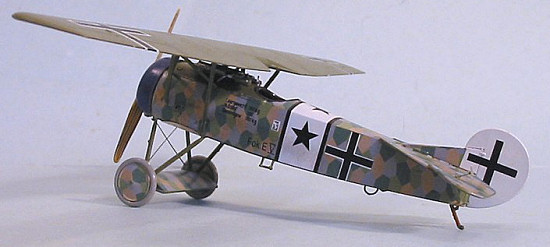 first all-wood wing to be put into
operational service, it was also tested for glue strength. Half the wing was
exposed to the elements, which included three days of rain, as a result of which
the plywood surface became “wavy” and the leading edge could be dented easily.
Over the next five days it dried out and regained its former stiffness, but
three more days of rain led to blistering and cracking. Despite all this, when
the wing was dried out, it still passed the load tests. Orders were given to
use a better grade of varnish for protection.
first all-wood wing to be put into
operational service, it was also tested for glue strength. Half the wing was
exposed to the elements, which included three days of rain, as a result of which
the plywood surface became “wavy” and the leading edge could be dented easily.
Over the next five days it dried out and regained its former stiffness, but
three more days of rain led to blistering and cracking. Despite all this, when
the wing was dried out, it still passed the load tests. Orders were given to
use a better grade of varnish for protection.
At the competition, front-line pilots including Bruno Loerzer and Hermann Goering declared the V 28 superior overall to the other competitors.
Delivery began in July and aircraft reached frontline units in August. Jasta 6 scored the first Parasol victory on August 17. Unfortunately, by the middle of August, crashes had already occurred due to wing failure. Additionally, there were numerous engine failures due to lack of good castor oil. The E.V was grounded within a matter of days of its combat debut, and by the end of the month the cause of the wing failures was found to be due to faulty construction and the use of undersized rear spar parts. Production was halted at the end of August, and was not reinstated until October 8, 1918.
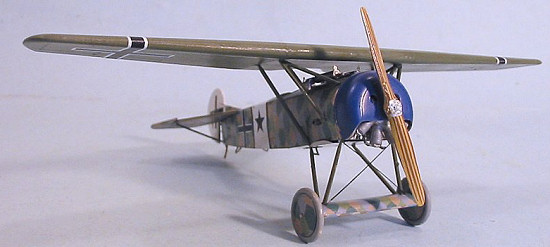 During the first few days of September, the wing was redesigned and
strengthened, and a new wing with heavier upper and lower rear spar sections was
delivered for tests on September 7. The wing passed all tests, and permission
to resume production was given on September 24. The new-build airplanes were
known as the D.VIII, as were the E.Vs with replacement wings. Fewer than 80
new-build aircraft were produced between October 8 - November 11, and the 85
Parasols reported at the front the end of October were almost all re-winged E.Vs.
Despite claims that the D.VIII would have become the primary German fighter had
the war continued, the truth is it had been eclipsed by the BMW-powered Fokker
D.VIIf and the Siemens-Shuckert D.III and D.IV, all of which had superior
high-altitude performance.
During the first few days of September, the wing was redesigned and
strengthened, and a new wing with heavier upper and lower rear spar sections was
delivered for tests on September 7. The wing passed all tests, and permission
to resume production was given on September 24. The new-build airplanes were
known as the D.VIII, as were the E.Vs with replacement wings. Fewer than 80
new-build aircraft were produced between October 8 - November 11, and the 85
Parasols reported at the front the end of October were almost all re-winged E.Vs.
Despite claims that the D.VIII would have become the primary German fighter had
the war continued, the truth is it had been eclipsed by the BMW-powered Fokker
D.VIIf and the Siemens-Shuckert D.III and D.IV, all of which had superior
high-altitude performance.
The E.V/D.VIII was never really combat-tested, due to the wing failures. Its main combat use came after the war, when the Freikorps organized by ex-Marineflieger ace Theo Osterkamp operated in the Baltics with a mixture of D.VII and E.V/D.VIII airplanes fighting the Bolsheviks. A few were also used by the new Polish Air Force.
The main item of importance that came from the development of this airplane was the Fokker all-wood cantilever wing, which was used on all his successful postwar designs.
| THE KIT |
The
very first 1/48 injection plastic model of this kit was produced by Aurora in
the late 1950s, as one of the last of their series of World War I airplanes.
Unfortunately, like most of this series, outline accuracy left “something to be
desired.” Since then, there have been two other Fokker “Parasols” issued as
injection-molded 1/48 kits - the very nice D.VIII released by DML in 1990, and
the E.V which was one of the very first limited-run kits made by Eduard in about
1993. Additionally, Bill Koster produced the most
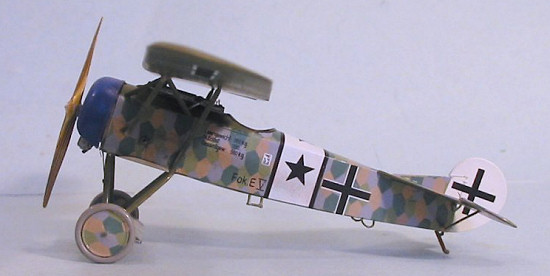 accurate 1/48 kit of this
airplane as a vacuform during the mid to late 1980s. The DML kit was never been
available in wide numbers and has been out of production for nearly 15 years,
driving its “retail” price into the kit collector’s stratosphere. The original
Eduard release, of which I made two, was one of those models that gave
limited-run World War I kits a reputation for being “difficult,” with its all-photoetch
cockpit interior and plastic parts that needed lots of test fitting to come
together.
accurate 1/48 kit of this
airplane as a vacuform during the mid to late 1980s. The DML kit was never been
available in wide numbers and has been out of production for nearly 15 years,
driving its “retail” price into the kit collector’s stratosphere. The original
Eduard release, of which I made two, was one of those models that gave
limited-run World War I kits a reputation for being “difficult,” with its all-photoetch
cockpit interior and plastic parts that needed lots of test fitting to come
together.
All these kits are effectively obsolete now and of interest only to plastic kit historians with the release of this new Eduard kit, which consolidates the company’s establishment of themselves as the “Tamigawa” of World War I models. 552 plastic parts and a fret of photo-etch that has seatbelts, machine gun jackets, engine wiring, and small details form the basis of this kit. The plastic is crisply-molded without any flash. Test-fitting reveals the parts fit as well as have those of the Camel, Bristol Fighter, and Fokker D.VII. The kit provides both early and late wings as one-piece moldings.
Lozenge is provided for the fuselage and tail, with individual markings for four of the best-known E.Vs, based on period photographs. This includes the E.V flown by Captain Stefan Bastyr of No. 7 “Koscziusko” Squadron of the Polish Air Force.
| CONSTRUCTION |
I doubt any World War I kit will ever be described as “throw the parts in the
air and they assemble themselves,” but this kit comes close. While I
didn’t keep an exact time log, I believe I spent more time waiting for paint to
dry and decals to set up than I
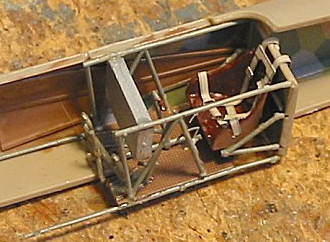 did
in assembling the model.
did
in assembling the model.
I began by painting all the interior details while the parts were still on the sprues, as well as applying lozenge decal to the interior of the fuselage sides. One this was done, it was simple to follow the very well-done instructions and assemble the cockpit interior. When I think back to the fits and the deep purple atmosphere over the workbench when I did this with the original photo-etch cockpit on the original Eduard Parasol, the ease with which I did this work was remarkable. I added in the photo-etch instruments and the seatbelts, and the cockpit sub-assembly went into the fuselage without the slightest problem.
The fuselage fit so well that I didn’t use any Mr. Surfacer to get rid of seams. I finished off first-stage assembly by separating the elevators from the horizontal stabilizer after I noticed that the decals were separate for these.
| COLORS & MARKINGS |
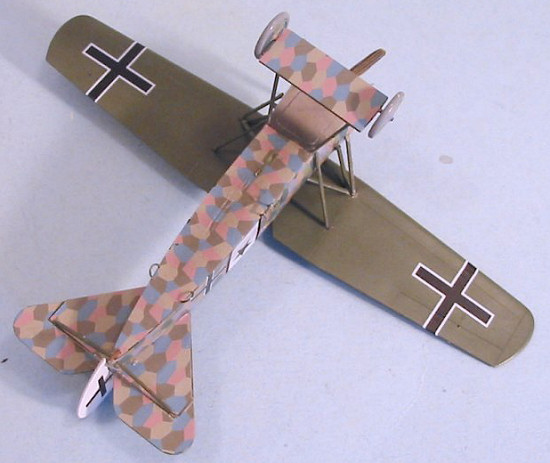 Painting:
Painting:
I painted the model overall Xtracrylix RLM 62 Green, which seems to be close to the “Fokker Green” that researchers like Ray Rimmell are now coming up with. I “post shaded” this on the upper forward fuselage decking and the wing with Xtracrylix RLM 83 mixed in to the RLM 62. I painted the cowling with Xtracrylix RLM 04 Blue.
Decals:
When all was dry, it was time for decals. I applied the lozenge decals for the fuselage, tail surfaces and “axle wing.” The decals went on easily and snugged down with no problem. When these were set up, I applied the markings for the Jasta 36 airplane. Eduard provides the fuselage stripe with both a black and a red star separately, since researchers have differed about this. Looking at the one photograph of this airplane, it seemed to me the star was tonally the same as the black edging to the white stripe, so I went with the black star decal. You could choose the opposite - and I thought about it for bringing more color to the model - without anyone being able to prove you wrong.
| CONSTRUCTION CONTINUES |
I glued the machine guns, tail surfaces, landing gear, engine, cowling, and wing struts to the fuselage, then attached the upper wing with cyanoacrylate glue. No problems were encountered with any of this, due to the precise fit of the parts. I finished off the model with bracing wire made from stretched sprue on the landing gear and for the control wires to the rudder and elevator.
| CONCLUSIONS |
This kit is the winner of the Gold-plated Plastic Pot for “Easiest World War I Model To Build Ever.” It is definitely a “weekend project,” with a result that is practically guaranteed to come out looking great. This would be an excellent kit for one to do as a first World War I model project, since you can learn that attaching the wing to the cabane struts is not as hard as you thought it would be.
Highly recommended for anyone who wants to add a beautiful World War I model to their collection.
February 2006
Thanks to Eduard for the review copy.
Copyright ModelingMadness.com. All rights reserved. No reproduction in part or in whole without express permission.
If you would like your product reviewed fairly and quickly, please contact the editor or see other details in the Note to Contributors.